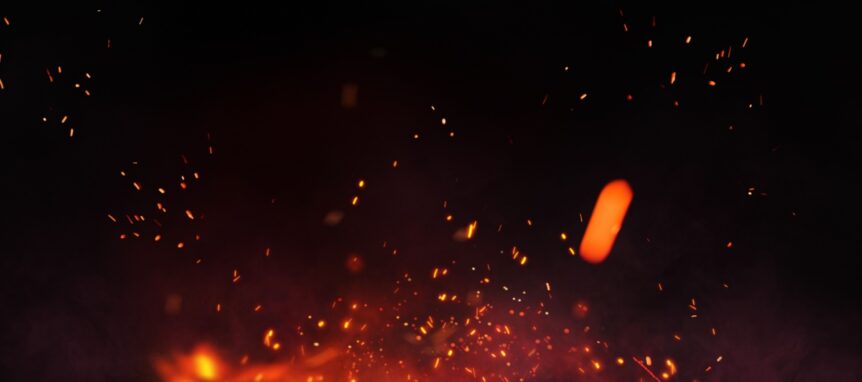Study results published in May 2025 link Chronic Nonallergic Rhinosinusitis (CNAR) with exposure to toxic burn pit smoke.
According to the study, chronic rhinosinusitis may be associated with deployment-related burn pit exposure and can impact previously deployed individuals’ well-being; standard-of-care treatments have the potential to improve their health. Enhanced awareness of the effects of toxic exposures on veterans’ health may aid in continuing to improve the quality of life of veterans. A systematic approach to evaluate sinonasal symptoms in previously deployed individuals may help appropriately identify and address post-deployment symptoms.
What is Chronic Nonallergic Rhinosinusitis?
We admit we had to look up this disease, so as a public service, we will save you the trouble of doing so yourself.
Chronic nonallergic rhinosinusitis (CNAR) is long-term inflammation of the nasal passages and sinuses unrelated to allergies. Unlike allergic rhinitis, which is caused by allergens like pollen or dust mites, CNAR is usually the result of infections, environmental irritants, or structural issues in the nasal cavity.
These “environmental irritants” could include toxic burn pit smoke. These open-air waste disposal pits were commonplace in Iraq and Afghanistan for many years. One of these pits, at Joint Base Balad in Iraq, was about the size of 10 football fields.
Usually, private military contractors get the dirty jobs. Burn pit maintenance may have been the dirtiest job imaginable. Therefore, contractors suffer from burn pit injuries at a disproportionate rate.
Symptoms of CNAR often mimic those of chronic allergic sinus problems and include nasal congestion, facial pressure or pain, postnasal drip, decreased sense of smell, and thick nasal discharge. These symptoms usually flare up periodically for long periods of time. Unlike allergic rhinitis, however, patients with CNAR do not test positive for allergens on skin or blood tests.
Diagnosis is typically made based on a physical examination, nasal endoscopy, CT scan, and a thorough review of the patient’s symptoms and history. Treatment for CNAR focuses on reducing inflammation and improving sinus drainage. Options include nasal saline irrigation, intranasal corticosteroids, antibiotics (if bacterial infection is present), and in some cases, surgery to correct structural problems.
Because CNAR is not allergy-related, traditional allergy medications such as antihistamines are usually ineffective. Instead, a tailored approach targeting the underlying inflammation is more beneficial.
Perhaps most importantly for our purposes, chronic nonallergic rhinosinusitis can significantly impact a person’s quality of life, causing ongoing discomfort and fatigue.
Presumptive Burn Pit Conditions
CNAR is not a presumptive burn pit condition. In both VA disability and Defense Base Act contractor injury claims (more on that below), the reviewing officer, who is usually an administrative law judge, must award benefits if the victim was exposed to burn pit smoke and developed one of the following conditions:
- Acute and chronic leukemias,
- Brain cancer,
- Gastrointestinal cancer of any type,
- Glioblastoma,
- Head cancer of any type,
- Kidney cancer,
- Lymphatic cancer of any type,
- Lymphoma of any type,
- Melanoma,
- Multiple myelomas,
- Myelodysplastic syndromes,
- Myelofibrosis,
- Neck cancer,
- Pancreatic cancer,
- Reproductive cancer of any type,
- Urinary bladder, ureter, and related genitourinary cancers,
- Squamous cell carcinoma of the larynx,
- Squamous cell carcinoma of the trachea,
- Adenocarcinoma of the trachea,
- Salivary gland-type tumors of the trachea,
- Adenosquamous carcinoma of the lung,
- Large cell carcinoma of the lung,
- Salivary gland-type tumors of the lung,
- Sarcomatoid carcinoma of the lung,
- Typical and atypical carcinoid of the lung,
- Respiratory (breathing-related) cancer of any type,
- Scan the QR code,
- Asthma that was diagnosed after service,
- Chronic bronchitis,
- Chronic obstructive pulmonary disease (COPD),
- Chronic rhinitis,
- Chronic sinusitis,
- Constrictive bronchiolitis or obliterative bronchiolitis,
- Emphysema,
- Granulomatous disease,
- Interstitial lung disease (ILD),
- Pleuritis,
- Pulmonary fibrosis, and
- Sarcoidosis.
Sadly, this long list is only a partial list of burn pit-related respiratory diseases, cancers, and other ailments. But look at it this way. The VA finally created a list of presumptive Agent Orange conditions over thirty years after the first victims were exposed to this toxic defoliant. So, burn pit victims are ahead of the curve.
Injured veterans and contractors with a disease, like CNAR, that isn’t on this list are eligible for benefits if they prove the following:
- Exposure to Burn Pit Smoke: Service records may be sufficient to establish exposure to burn pit smoke in a VA disability or DBA claim. However, a Defense Base Act lawyer often introduces additional evidence, such as buddy statements, that shore up the evidence on this element.
- Current Diagnosis: Most VA and DBA applicants see doctors affiliated with the VA or a DBA insurance company. These doctors often make vague diagnoses in order to avoid the presumptive condition list. A DBA lawyer connects a victim with a doctor who calls a spade a spade and accurately diagnoses an illness.
- Smoke-Illness Connection: Usually, a doctor must tie the victim’s illness to one of the toxic ingredients in burn pit smoke.
- Service-Related Connection: VA disability claimants must prove a direct service-related connection (the victim was exposed to burn pit smoke while on duty). DBA victims must only prove an indirect connection (the victim was exposed to burn pit smoke in Iraq, Afghanistan, or another place, but not necessarily while on active duty).
The burden of proof, which is as likely as not, is the same in both VA disability and DBA disability proceedings. Although this standard of evidence is very low, DBA lawyers usually introduce additional evidence in order to obtain maximum benefits.
VA and DBA: Similarities and Differences
As mentioned, basically the same benefits are available in both forums. However, the specifics are different.
VA disability pays a monthly cash stipend based on the degree of disability (10%, 20%, etc.). These victims are also eligible for free medical care at any VA medical facility.
DBA victims usually receive two-thirds of their AWW (average weekly wage) for the duration of their total or partial temporary or permanent disabilities. Furthermore, the DBA insurance company must pay all reasonably necessary medical bills.
The differences are significant and too numerous to list in this post. So, we will focus on one, which is the burn pit victim outlook.
VA disability is a burn pit victim-unfriendly system. The VA did not create a list of presumptive burn pit illnesses until 2024. And, as mentioned, VA doctors often carefully word their reports to avoid the presumptive conditions. So, the victim has a heavy burden to prove.
In contrast, the DBA system is burn pit-friendly. In the late 2010s, a Department of Labor administrative law judge ruled that there’s a connection between DRLD (deployment-related lung disease), an umbrella term that covers most service-related respiratory conditions, and toxic burn pit smoke. So, instead of starting from scratch, a Defense Base Act lawyer starts each case with a distinct advantage.
Most injured private military contractors are eligible for Defense Base Act benefits, even if they are foreign nationals, like translators, who worked for a contractor.
For more information about DBA benefits, contact Barnett, Lerner, Karsen, Frankel & Castro, P.A.

